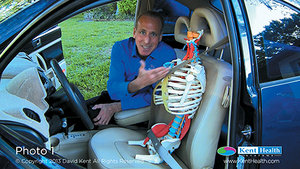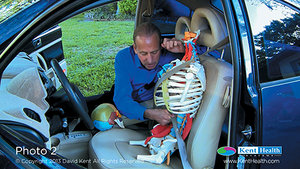Since opening my clinic in 1992, I have treated numerous individuals with soft-tissue traumas resulting from a motor vehicle accident (MVA). According to the Centers for Disease Control and Prevention (CDC), approximately 6,400 adults are injured daily in a crash.
Newton's First Law of Motion, sometimes referred to as the law of inertia, basically states: An object at rest stays at rest and an object in motion stays in motion, at a constant speed and direction, unless acted upon by an outside force. When you are seated in a motor vehicle traveling 35 miles per hour and it suddenly stops, inertia continues to move your body forward. Only a thin strip of fabric, the seat belt, holds your body in place. It prevents you from flying forward, at a speed of 35 miles per hour that converts to 51.34 feet per second, and smashing into the dashboard and windshield. A crash happens in a fraction of a second.
 For seat belts to perform, the seat and person must be in the correct position. The seat back should be upright. The person should sit on their ischial tuberosities, with the hips, back and shoulders against the seat back.
For seat belts to perform, the seat and person must be in the correct position. The seat back should be upright. The person should sit on their ischial tuberosities, with the hips, back and shoulders against the seat back.
Before buckling the seat belt, confirm the material is flat and not twisted like a rope that could potentially cut into the body. The lap portion of the seat belt should be positioned across the pelvis, just below the anterior superior iliac spine (ASIS). (Photo 1) Often, the lap belt is placed too high across the abdomen. In this position, during a collision the lap belt cuts deep into the abdomen, causing trauma to the rectus abdominis, abdominal oblique muscles and internal organs. (Photo 2)
 The shoulder belt should be positioned across the rib cage, sternum and midpoint of the clavicle. (Photo 1) Never place the shoulder belt under your arm or behind your back. Internal organs are less likely to be injured when seat belts are positioned correctly. (Photo 3)
The shoulder belt should be positioned across the rib cage, sternum and midpoint of the clavicle. (Photo 1) Never place the shoulder belt under your arm or behind your back. Internal organs are less likely to be injured when seat belts are positioned correctly. (Photo 3)
Remove any slack between the seat belt and the body to reduce the potential for movement during an accident. If adjustable, position the head restraint or "headrest" to minimize movement of the head during a collision. (Photo 3) Often the headrest is too low, causing the neck to hyperextend and resulting in additional trauma.
 Seat belts also cross the locations of myofascial trigger points in the rectus abdominis, which often refers pain into the abdomen and back. A picture is worth a thousand words. Use visual aids like postural analysis photos and trigger-point charts to educate patients of the myofascial involvement of their pain.
Seat belts also cross the locations of myofascial trigger points in the rectus abdominis, which often refers pain into the abdomen and back. A picture is worth a thousand words. Use visual aids like postural analysis photos and trigger-point charts to educate patients of the myofascial involvement of their pain.
There is a big difference between knowing what to do and doing want you know. Build your practice and protect yourself, family, friends and patients by applying and sharing seat-belt safety protocols.
Editor's note: All photos in this article copyright of Kent Health Systems and reproduced in this article with permission.




